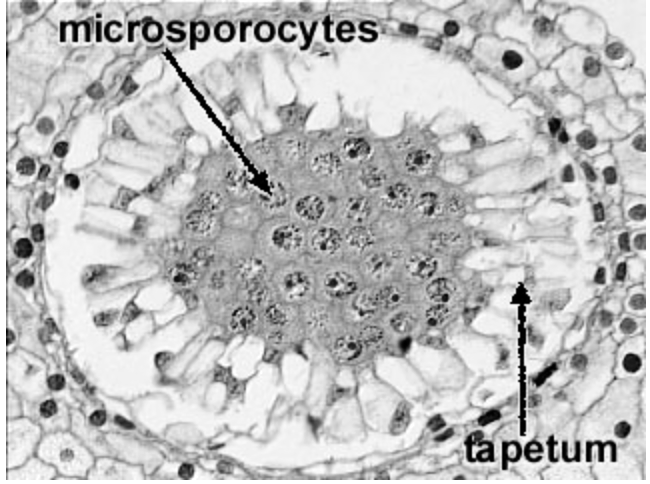
Which function of Tapetum is correct?
(a) Helps in a pollen wall formation
(b) Transportation of Nutrients to the inner side of the anther.
(c) Synthesis of Callase enzyme for separation of microspore tetrads
(d) All of these.
Answer
572.7k+ views
Hint: Tapetum is the innermost layer of anther wall which surrounds the sporogenous tissue. The tapetal cells help in the subsistence of maturing pollen grains. They play a major role in the development of pollen grains.
Complete Step by Step answer:
Tapetum is very important for the nutrition and development of pollen grains, also as a source of precursors for the pollen coat. Secretion of the enzyme callase (β- 1,3- glucanase) to dissolve the callosic wall of the tetrad and to set them free. Formation of the pollen wall during the postmeiotic period is also done

The anther wall layers consist of the following layer: - Epidermis - Endothecium - Middle layer - Tapetum. The two main types of tapetum are secretory or glandular tapetum and amoeboid/plasmodium tapetum. - Secretary tapetum secretes sporopollenin, pollen Kitt, and compatibility proteins. These cells provide Ubisch bodies that help in the ornamentation of the exine. - Amoeboid tapetum: Cells undergo breakdown and their entire protoplasts move towards the center to nourish the pollen grain.
An increase in DNA content of tapetum may be achieved by the following ways: - Endomitosis: It involves DNA replication and the splitting of chromosomes. - Restitution nucleus: It involves normal mitosis up to anaphase but the chromosomes at two poles get surrounded by a common nuclear membrane. - Polyteny: If DNA replication is not accompanied by the splitting of chromosomes polytene chromosomes are formed.
So, the correct answer is, ‘(d) All of these.’
Note: Pollen Kitt is a sticky and sugary substance made up of lipids and starch which is also known as pollen coat. It helps the pollen to stick to the bugs.
Complete Step by Step answer:
Tapetum is very important for the nutrition and development of pollen grains, also as a source of precursors for the pollen coat. Secretion of the enzyme callase (β- 1,3- glucanase) to dissolve the callosic wall of the tetrad and to set them free. Formation of the pollen wall during the postmeiotic period is also done

The anther wall layers consist of the following layer: - Epidermis - Endothecium - Middle layer - Tapetum. The two main types of tapetum are secretory or glandular tapetum and amoeboid/plasmodium tapetum. - Secretary tapetum secretes sporopollenin, pollen Kitt, and compatibility proteins. These cells provide Ubisch bodies that help in the ornamentation of the exine. - Amoeboid tapetum: Cells undergo breakdown and their entire protoplasts move towards the center to nourish the pollen grain.
An increase in DNA content of tapetum may be achieved by the following ways: - Endomitosis: It involves DNA replication and the splitting of chromosomes. - Restitution nucleus: It involves normal mitosis up to anaphase but the chromosomes at two poles get surrounded by a common nuclear membrane. - Polyteny: If DNA replication is not accompanied by the splitting of chromosomes polytene chromosomes are formed.
So, the correct answer is, ‘(d) All of these.’
Note: Pollen Kitt is a sticky and sugary substance made up of lipids and starch which is also known as pollen coat. It helps the pollen to stick to the bugs.
Recently Updated Pages
Master Class 12 English: Engaging Questions & Answers for Success

Master Class 12 Business Studies: Engaging Questions & Answers for Success

Master Class 12 Economics: Engaging Questions & Answers for Success

Master Class 12 Social Science: Engaging Questions & Answers for Success

Master Class 12 Maths: Engaging Questions & Answers for Success

Master Class 12 Chemistry: Engaging Questions & Answers for Success

Trending doubts
Draw a labelled sketch of the human eye class 12 physics CBSE

Explain sex determination in humans with line diag class 12 biology CBSE

The pH of the pancreatic juice is A 64 B 86 C 120 D class 12 biology CBSE

Explain sex determination in humans with the help of class 12 biology CBSE

Differentiate between homogeneous and heterogeneous class 12 chemistry CBSE

Which state in India is known as the Granary of India class 12 social science CBSE




